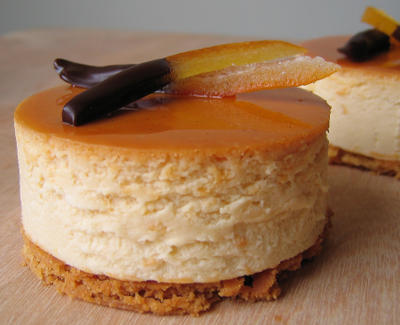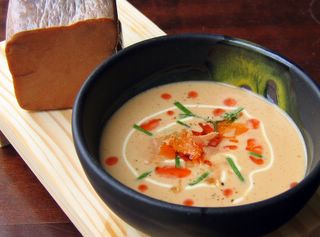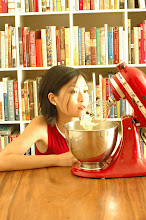
Ahh...cookbooks. I will start by coming clean about my habit. What started off many years ago as an innocent-enough by-product of my love for cooking - a core collection of beloved essentials and classics - has taken on a life of its own and grown off-shoots of the most esoteric variety, depending on which obsession I'm in the grip of. You know you have gone over the edge when you entertain such ponderous questions at the bookshop as "Is my collection complete without a Georgian cookery book?" and are severely tempted to answer in the negative. You know you need help when you start sneaking new books home despite the fact that you really don't have the space for them just so as to avoid raised eyebrows from loved ones. Pleasure, it seems, is that much more so when it's guilty...
Was tagged by
Nibble & Scribble for this cookbook meme and have answered the questions below. And while we're on the subject of cookbooks, have taken the liberty of answering the highly thought-provoking questions by Anthony of Spiceblog in his
cookbook meme as well. I don't know if this two-headed post violates some unsaid meme law or not. Anyways...
1. Total number of cook books I've ownedDoes two Ikea shelving units worth count as a quantifiable? Discounting wine books, food essay anthologies, food related memoirs, food history books and the ilk, a conservative estimate would be just shy of 300. Is this too few or too many, and is there such a thing as owning too many (incidentally, in The Pedant in the Kitchen, Julian Barnes has written a hysterical
essay on the subject)?
 2. Last cookbook I bought
2. Last cookbook I boughtAlain Ducasse's Culinary Encyclopedia,
Grand Livre de Cuisine, a gargantuan tome brimming with highly involved haute cuisine dishes that more often than not cross-reference at least three others. What valid reason (read: excuse) do I have for parting with a rather obscene amount of money for a book I am likely to use only very occasionally? I present, here, the diary of a bookshop food section indweller:
Day 1: Spy brand new shipment of Grand Livre de Cuisine! Only 5 copies! Ouch! Incredibly exorbitant pricetag. Retreat home to calm down and think about it.
Day 2: Can't stop thinking about book. Return to bookshop. 3 copies remain. Pulse races. I want, I want, I want! I mean, I need, I need, I need! Feel light-headed. Retreat home to lie down.
Day 3: Have decided to return and if there remains a copy, I shall take it as a divine sign. There remains a copy. And what looks to be a hotel restaurant sous chef (Austrian, mid-30s, unshaven, looks like he hasn't slept in years) is headed in the same direction. I swoop in and snatch up the book, almost spraining my wrist in the process (book weighs in at over 1000 pages).
 3. Last food book I readMes Confitures
3. Last food book I readMes Confitures and
Mes Tartes, concurrently, by Christine Ferber, otherwise known as
la fee des confitures, "the jam fairy". Handcrafted in the traditional way in the picturesque village of Niedermorschwihr in Alsace, Ferber's jams are made from local seasonal fruit, cooked in small batches using copper pans. Outside of Au Relais des Trois Epis, her boulangerie-patisserie in Alsace, Ferber's exquisite and special confitures, charmingly be-ribboned and clad in polka-dotted packaging, can be found in only the most exclusive of Parisian gourmet establishments. She also supplies culinary world heavyweights such as Alain Ducasse, the Troisgros family, and Pierre Herme, to name a few. Of the flavours I have had the opportunity to try, my favourite is Confiture Ispahan, which Ferber makes for Pierre Herme. It captures in a jar the ethereal taste of Herme's signature macaron, the Ispahan - a celestial creation comprising of two rose water-flavoured macarons sandwiching a delicious lychee cream and whole raspberries. The recipe, unfortunately, is not in her book. Nonetheless, having always wanted to be the sort of domestic goddess with a larder full of home-made preserves, this book makes for compulsive reading. Jams and jellies, here I come!
 4.Five cookbooks that mean a lot to me
4.Five cookbooks that mean a lot to me2 are old friends, the other 3 more recent influences. My tatty copies of Elizabeth David's
French Provincial Cooking and Richard Olney's
Simple French Food were acquired in my university days, when I spent every waking moment and every penny of spare cash at Books for Cooks, a veritable sanctuary for cookbook addicts in Notting Hill, London, rather than attending lectures and acquiring, say, textbooks.
Family Food by Heston Blumenthal and
Bouchon by Thomas Keller are on this list because the food they are cooking leads the pack. Short of eating at The Fat Duck, The French Laundry and Bouchon (which I one day will), I want to learn as much as I can about/from these modern masters. In his book, Heston Blumenthal looks at comfort food staples we all want to eat (like mashed potatoes and roast beef), as opposed to cheffy conceits designed to earn stars, through the lens of molecular gastronomy thus making the subject accessible and relevant to all. In Bouchon, Thomas Keller meticulously and methodically re-thinks the techniques and processes behind such bistro gold standards like boeuf bourguignon and creme caramel - there isn't a single recipe in this book I am not inspired to try. And finally,
Chocolate Desserts by Pierre Herme, written by Dorie Greenspan, because I am totally fixated with the Picasso of Pastry's breathtaking sweets, and nothing would give me more personal satisfaction at this point than to cook my way through every single recipe.
5. Which 5 people would you like to see fill this out in their blog?I can't think of anyone who hasn't already filled out at least one of the 2 cookbook memes. And if I'm wrong, to-whom-it-may-concern, please feel free to correct me by filling it out and/or passing it on!
And now for Spiceblog's questions...
1. Rationale behind what we're seeing?
Organised by subject, author and region/country on flimsy shelves evidently not designed to take the weight of this number of books. A bookcase upgrade is in order, as well as the devising of a new organizational system, both subjects on which merit a new post entirely.
2. Most recommended?
Harold McGee's
On Food & Cooking (the new vastly updated and revised edition, not the 1984 one), and Shirley Corriher's
Cookwise will answer every question you ever had regarding why a recipe didn't turn out perfectly. Nigel Slater's
Appetite and Stephanie Alexander's
The Cook's Companion are great all-rounders that will answer the daily question of "What shall I cook today?" in an admirably stylish fashion. For when you're feeling ambitious, there's Tom Colicchio urging you to
Think Like A Chef (nobody ever did say it was going to be easy...). And to spur you on to even greater heights (home-ground, mixed, cured, cased and fermented Soppressata, anyone?), there's
Cooking By Hand by Paul Bertolli, a paean to the joys of cooking from scratch.
3. Cookbook that made you what you were?
Keep It Simple by Alastair Little, which was the first book to de-mystify classic cookery for me, and taught me the vital importance of mise en place - thinking and planning ahead - in cooking.
4. Porniest cookbook?
Tie between
The French Laundry Cookbook by Thomas Keller, which gets my salivary glands going into overdrive every time I open it, and
Shunju: New Japanese Cooking by Takashi Sugimoto & Marcia Iwatate, an enigmatic confluence of austere Zen-like beauty and latent sensuality.
5. Sophie's Choice cookbook?
Asking me to choose one to save is akin to asking a mother which of her drowning brood to rescue.
6. If you were a cookbook, which cookbook would you be?
How to be a Domestic Goddess by Nigella Lawson? The title may have been ironically intended by the author, but sadly enough, yes, it perfectly sums up my chief ambition in life.
7. If your cookbooks were extremely valuable, so valuable you might hide it with other valuables, where would that place be? This is classified information.
 I had brought back some lovely scorzetta d'arancia candita (candied orange peel) and a bottle of Cantine Florio's delicious Targa Riserva 1840 (a Vendemmia 1997 Vino Marsala Superiore Riserva) from Sicily with the vague intent of using the former to flavour either cannoli or cassata and to drink the latter with said dessert. The gem-like succulent wedges of candied peel are entirely different from the often waxen and tasteless travesty in plastic tubs available at the Baking Needs aisle of your friendly neighbourhood supermarket. For starters, these actually taste of oranges, rather than chemical preservatives and colouring agents. As for the semisecco ambra wine, it's an elegant dessert wine crafted from selected Grillo grapes picked at peak maturity from vineyards along the coastal strip of Petrosino in Triglia. A fortified wine aged for 6 years in oak casks then matured for at least 6 months in bottle, the Targa Riserva 1840 is beautifully amber in hue. Profusely aromatic like a Christmassy spiced dried fruit compote, the flavour is full, warm and mellow. While scrumptious sipped on its own or paired with a fine pastry, the baker in me simply couldn't resist flavouring a dessert with it. Homework on which cannoli or cassata recipe to follow (currently, the recipes in Nick Malgieri's Great Italian Desserts, Victoria Granof's Sweet Sicily, and Mary Taylor Simeti's Bitter Almonds look the most enticing) not having been completed, I decided I would incorporate both the candied orange peel and marsala in some other dessert, namely cheesecake, the logic being that both flavours tasted great in ricotta-based pastry creams so why not some other mild creamy cheese?
I had brought back some lovely scorzetta d'arancia candita (candied orange peel) and a bottle of Cantine Florio's delicious Targa Riserva 1840 (a Vendemmia 1997 Vino Marsala Superiore Riserva) from Sicily with the vague intent of using the former to flavour either cannoli or cassata and to drink the latter with said dessert. The gem-like succulent wedges of candied peel are entirely different from the often waxen and tasteless travesty in plastic tubs available at the Baking Needs aisle of your friendly neighbourhood supermarket. For starters, these actually taste of oranges, rather than chemical preservatives and colouring agents. As for the semisecco ambra wine, it's an elegant dessert wine crafted from selected Grillo grapes picked at peak maturity from vineyards along the coastal strip of Petrosino in Triglia. A fortified wine aged for 6 years in oak casks then matured for at least 6 months in bottle, the Targa Riserva 1840 is beautifully amber in hue. Profusely aromatic like a Christmassy spiced dried fruit compote, the flavour is full, warm and mellow. While scrumptious sipped on its own or paired with a fine pastry, the baker in me simply couldn't resist flavouring a dessert with it. Homework on which cannoli or cassata recipe to follow (currently, the recipes in Nick Malgieri's Great Italian Desserts, Victoria Granof's Sweet Sicily, and Mary Taylor Simeti's Bitter Almonds look the most enticing) not having been completed, I decided I would incorporate both the candied orange peel and marsala in some other dessert, namely cheesecake, the logic being that both flavours tasted great in ricotta-based pastry creams so why not some other mild creamy cheese?































